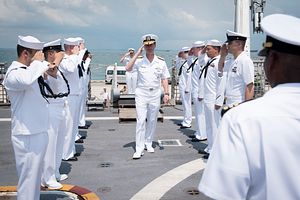The U.S. Navy’s Chief of Naval Operations, Admiral John Richardson, visited the Nimitz-class nuclear-powered supercarrier, USS John C. Stennis, in the South China Sea over the weekend, a U.S. Navy video reveals.
The admiral’s two-day stop aboard the USS John C. Stennis occurs amid rising regional tensions over disputed territories in the South China Sea, and appears to be a signal to China that the United States will remain present in what Beijing claims are its waters.
“Everybody in the region is concerned about the stability, peacefulness and the prosperity of this region,” said in the video posted on Facebook. “As I talk to them, I know it’s going to be OK because we have the John C. Stennis Strike Group on station here in the South China Sea.”
The admiral addressed the crew through the ship’s close-circuit television. “When they talk about regional security, when they talk about stability, when they talk about maintaining the peace, when they talk about understanding the strategic implications of this part of the world, they’re talking about you,” said Richardson.
The last high-ranking U.S. official to visit the USS John C. Stennis in the South China Sea was U.S. Defense Secretary Ashton Carter, who, along with Philippine Secretary of National Defense Voltaire Gazmin, visited the aircraft carrier in April 2016.
“We want to reduce tensions, but we also want everybody in the region to be able to rise and develop in their own way — including the Philippines, by the way, which happens also to be a longstanding and very staunch treaty ally of the United States,” Carter said while aboard.
In May, two Chinese fighter aircraft flew perilously close to a U.S. EP-3 Aries signals reconnaissance aircraft, an encounter the United States called a “dangerous intercept.” However, the head of U.S. Pacific Command, Admiral Harry Harris, noted in Singapore during the annual Shangri-La security dialogue that Chinese pilots are behaving more positively overall.
“We have seen positive behavior in the last several months from China,” he said, according to Bloomberg News. “You know every now and then you’ll see an incident in the air that we may judge to be unsafe, but those are really over the course of time rare.” Admiral Richardson, who also spoke at the Shangri-La Dialogue, concurred with the Harris’ assessment: “Every now and then we’ve got an outlier and we need to address those when they happen.”
The flyby incident in May occurred a few days after the U.S. Navy conducted its third freedom of navigation operation (FONOP) near the disputed Spratly Islands, with the guided-missile destroyer USS William P. Lawrence sailing within 12 nautical miles of Fiery Cross Reef, an artificial island on which China is constructing a 3,000 meter airstrip.
In May, the Chinese government cancelled a scheduled port visit to Hong Kong by the USS John C. Stennis in what is perceived a tit-for-tat for U.S. Navy FONOPs in the South China Sea. The Hong Kong port visit of the Blue Ridge-class command ship, USS Blue Ridge, the floating headquarters of the U.S. Navy’s Japan-based 7th Fleet, however, was not affected.
The USS John C. Stennis is conducting what the U.S. Navy calls routine operations in the South China Sea. The ship is accompanied by the Arleigh Burke-class Aegis destroyers USS Chung-Hoon, USS William P. Lawrence and USS Stockdale, as well as theTiconderoga-class guided-missile cruiser USS Mobile Bay.

































